Introduction
Click on the audio player to listen to the lesson introduction.
What you will learn
After completing this learning activity, you will be able to:
- describe and compare theories of child development
- identify and assess common myths and false assumptions about early childhood development
Consult the acknowledgements (Opens in a new window) for this course.
Who are you?
Elvis Presley used to sing a song called “The Wonder of You” and he was right. You are a wonder. You are unique. There is no one quite like you. Maybe you are very tall, or you play guitar. Or maybe you speak another language or you have an extra toe. What is it? What makes you you?

Right now, name three things that make you unique:
Growth and development
You described three things that make you unique. Believe it or not, you described the results of your growth and development. These words will be used in a specific way in this course.
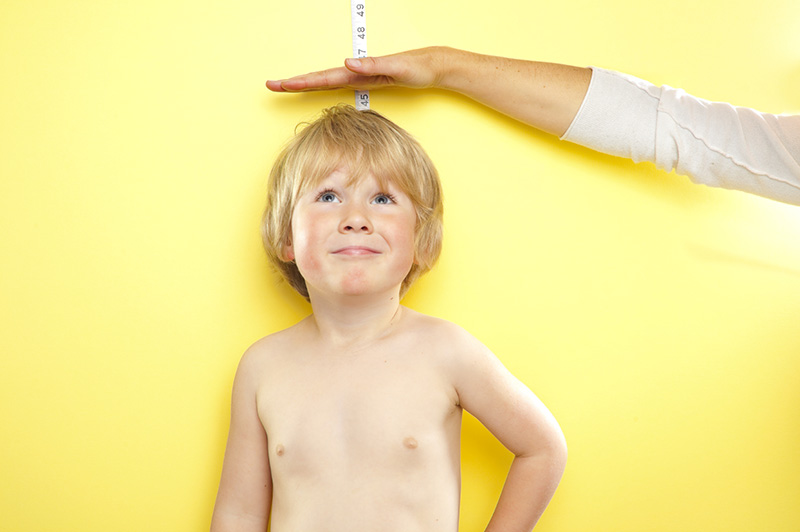
Growth will usually refer to an increase in physical size and will include changes in appearance and body functions. It is considered objective quantitative data (meaning it can be measured). For example, when you were quite young someone took you to a pediatrician, who measured your height and added this quantitative data to your medical records. Such records are one way to describe the results of growth.
Development is the process of gradual biological, emotional, and psychological changes that take place. Changes range from simple to complex. They are affected by your learning (nurture) and your genes (nature). Changes are also affected by many chance events and environmental factors. Maybe you speak two languages. This may be because you lived in the country where the language was spoken or you learned the language from your grandmother or caregiver. This is part of your development. Very often development is described in qualitative ways, which means that development is expressed in descriptive words instead of in measurement with numbers.
Factors that affect development
Would you say that many factors or life experiences have influenced who you are?
If you said yes, then you are like most people.
Factors that affect development can be very diverse. For one person it might be the presence or absence of a particular opportunity. For example, someone might want to go to university to become a doctor but they have to work full time and support their family so they cannot because of “life circumstances.” Life circumstances are one of the factors that affect a person’s development.
In the next section you will be able to test your knowledge about the factors that affect a person’s development.
Which of these factors have most affected your own development?
Write them in the text box now.
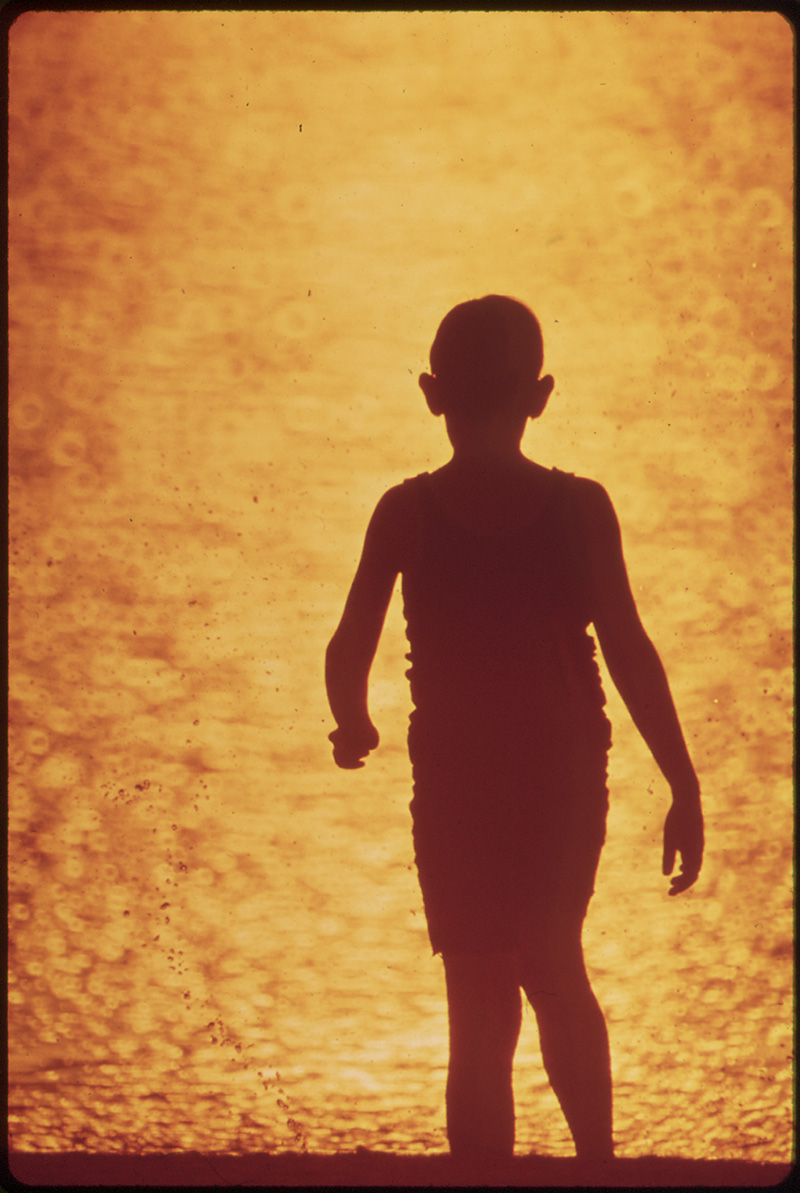
Scenario: About a boy
Using what you have learned about growth and development and the factors that affect development, how do you think these boys’ development might be affected by each of the circumstances shown in the next section?

Meet Josiah
During his first five years of life, his family did not have enough money to feed him properly. Identify which kind of developmental factor is being described and explain what might happen as a result of the circumstance.
This is a nutrition factor. He may develop a learning disability. His body systems may be compromised so that they never function as well as they would have if he had received proper nutrition. He could develop serious health issues like rickets. His bones and teeth may not develop properly. He may be chronically ill as his immune system may not be very strong. He may die.
He lived in an area where the air and water were heavily polluted. Identify which kind of developmental factor is being described and explain what might happen as a result of the circumstance.
This is a life circumstances factor. He may develop E. coli infections. He may permanently damage his stomach, intestines, and bowels. He may develop chronic diarrhea. He may die.
His parents were unable to care for him and he had to live with another family. Identify which kind of developmental factor is being described and explain what might happen as a result.
This is a life circumstances factor and a coping mechanism factor. He may feel lonely or abandoned.
His home was in an unsafe neighbourhood. Identify which kind of developmental factor is being described and explain what might happen as a result of the circumstance.
This is a life circumstances factor. He may learn about violence at an early age and how to survive with the help of weapons, stealing, and crime. He may be injured or die.
He was physically abused. Identify which kind of developmental factor is being described and explain what might happen as a result of the circumstance.
This is a life circumstances factor. He may have long-lasting injuries. He may learn not to trust others. He may become shy and withdrawn or overly aggressive.
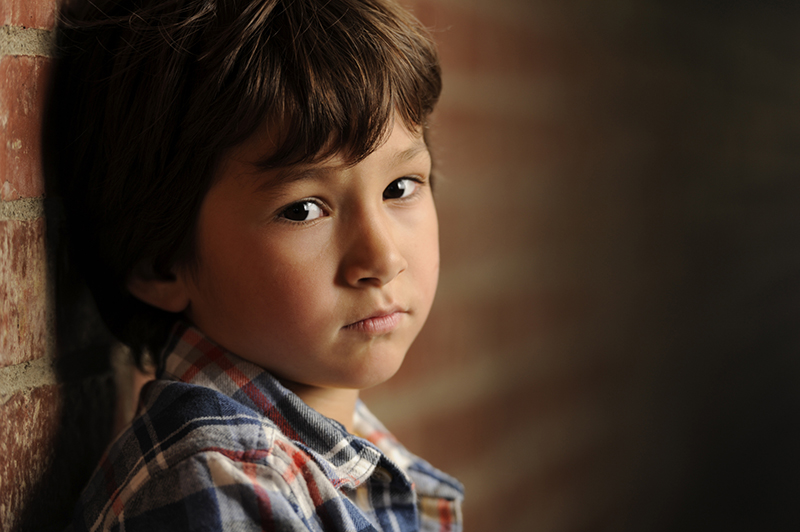
Meet Sam
He was bullied by other children at school. Identify which kind of developmental factor is being described and explain what might happen as a result of the circumstance.
This is a life circumstances factor. He may have long-lasting injuries. He may learn not to trust others. He may become shy and withdrawn or overly aggressive.
He dropped out of school. Identify which kind of developmental factor is being described and explain what might happen as a result of the circumstance.
This is an education factor. He may work at low paying jobs and become trapped in a cycle of poverty. He may be resentful or give up hope for a better future.
He lost almost all of his vision because of an inherited condition. Identify which kind of developmental factor is being described and explain what might happen as a result of the circumstance.
This is a biology factor. He may struggle to learn and work and have relationships. He may have to go to a special school. He may be delayed in some of his important milestones.
Of all the factors, do you think some are more common than others? If so, which ones?
There is much research that rather than a single factor being most important, it is the accumulated effect of several factors that makes the real difference. In other words, it is the cumulative impact of both early and later experiences that determines a child’s development.
Scenario: About a boy
Why is it so important to say “may” when it comes to the issue of whether factors will have an impact on a child’s development?
Because people are remarkable and children, in particular, are very adaptable. Many people in this world have thrived despite significant developmental factors. For example, although blindness can have a significant impact on development it does not mean that atypical developmental milestones will not be met. Many have exceptionally successful careers and happy, satisfying lives. But blindness is a developmental factor that may be biological and it is a factor that may result in developmental challenges.
Just as there are several potential developmental outcomes to the scenario you just completed, there are several theories about child development. Each theory has strengths and weaknesses, and you will learn that one theory may help you understand certain aspects of a person’s development while another theory helps you to understand other aspects.
Types of development theories
Many theorists have tried to describe human development. The theories they came up with can be grouped into three types: psychoanalytic, cognitive, and multi-faceted.
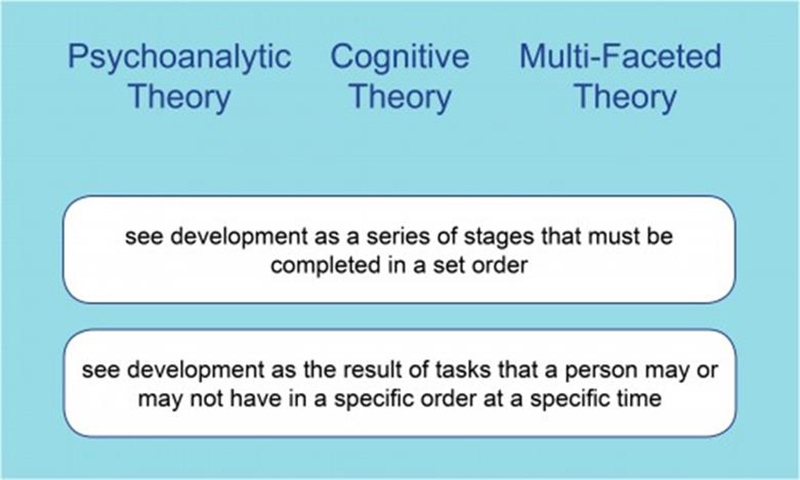
Three categories of human development theories; “Psychoanalytic theory,” “Cognitive theory,” “Multi-faceted theory.” Within each are both approaches: “see development as a series of stages that must be completed in a set order” and “see development as the result of tasks that a person may or may not have in a specific order at a specific time”
As shown in the image, there are two common approaches that apply to each theory.
Listen to this voice-only recording on human development theories.
As you listen, fill in the blanks in this paragraph on “Fill in the blanks: Human development theories (Opens in new window).”
Sigmund Freud
We will start with the first type of development: psychoanalytic theory.
“Children are completely egoistic; they feel their needs intensely and strive ruthlessly to satisfy them.” Or so said a famous behavioural scientist named Sigmund Freud.
Do you agree with Freud’s statement?
Before you decide, it might help to know that Sigmund Freud explored how our personality develops. He is best known for his work describing the conscious and the unconscious mind.
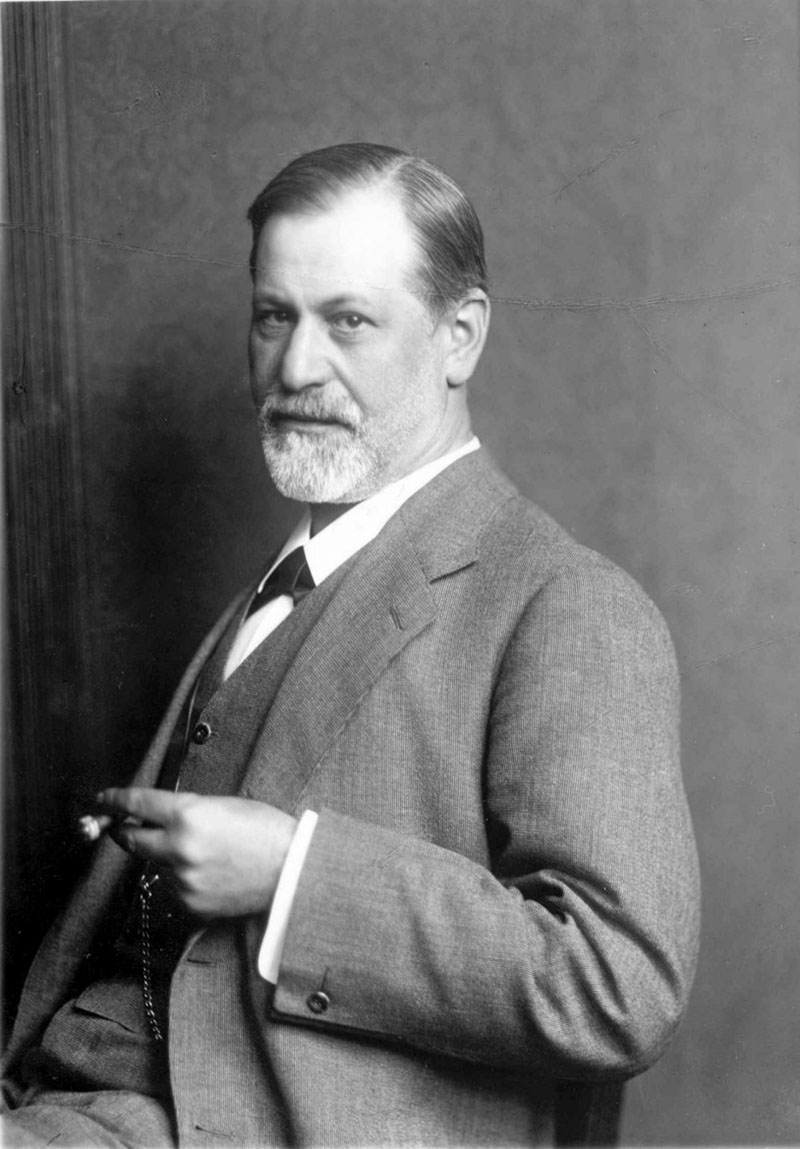
Watch the video on Sigmund Freud’s theory of the conscious and unconscious mind.
Feel free to search for and watch a couple of other videos on the topic until you feel you have grasped what Freud was saying. Be sure to jot down your own notes as you watch and listen. Remember that you are responsible for all the learning in the course, even what you learn from videos or animations.
Once you have learned about Freud, fill in the blanks in the paragraph on “Fill in the blanks: Freud’s theory (Opens in new window)” to compile a summary for your study notes.
Erik Erikson
Erik Erikson’s theory of psychosocial development is one of the best-known theories of personality in psychology. Much like Sigmund Freud, Erikson believed that personality develops in a series of stages. But unlike Freud’s theory of the conscious and the unconscious mind directing our behaviour, Erikson said the conscious self continues to develop through social interactions throughout one’s life and that people are motivated by a desire for a sense of competence.
Each stage in Erikson’s theory is concerned with becoming competent in an area of life. If the stage is handled well, the person will feel a sense of mastery. If the stage is managed poorly, the person will emerge with a feeling of inadequacy. During these stages, the potential for personal growth is high, but so is the potential for failure.
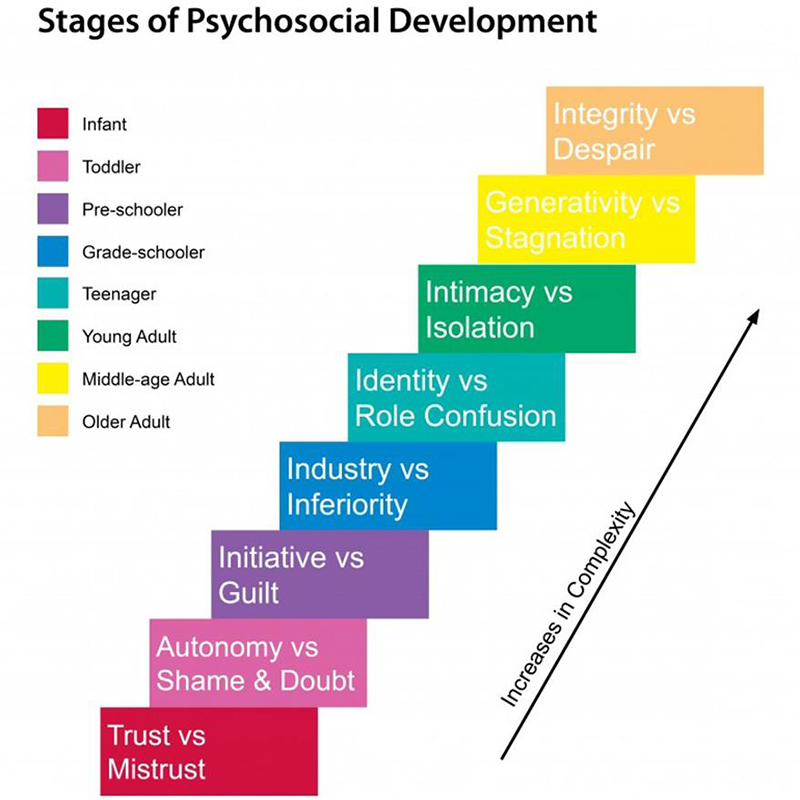
Erikson’s stages of psychosocial development; from bottom to top, increasing in complexity. Infant: trust vs. mistrust, toddler: autonomy vs shame & doubt, pre-schooler: initiative vs. guilt, grade-schooler: industry vs. inferiority, teenager: identity vs. role confusion, young adult: intimacy vs. isolation, middle-aged adult: generativity vs. stagnation, older adult: integrity vs. despair.
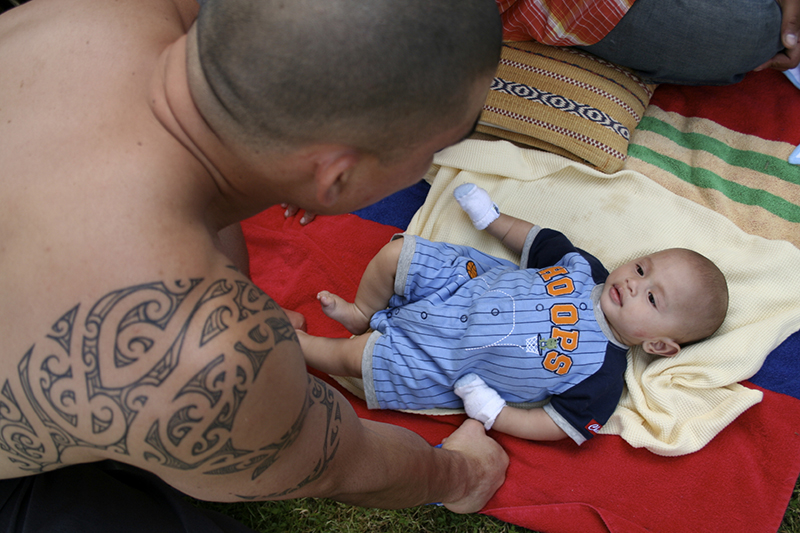
The first stage of Erikson's theory of psychosocial development occurs between birth and one year of age and is the most fundamental stage in life.
Because an infant is utterly dependent, the development of trust is based on the dependability and quality of the child's caregivers.
If a child successfully develops trust, he or she will feel safe and secure in the world. Caregivers who are inconsistent, emotionally unavailable, or rejecting contribute to feelings of mistrust in the children they care for.
Failure to develop trust will result in fear and a belief that the world is inconsistent and unpredictable.

The second stage of Erikson's theory of psychosocial development takes place during early childhood and is focused on children developing a greater sense of personal control.
Like Freud, Erikson believed that toilet training was a vital part of this process. However, Erikson's reasoning was quite different than Freud's. Erikson believed that learning to control one's bodily functions leads to a feeling of control and a sense of independence.
Other important events include gaining more control over food choices, toy preferences, and clothing selection.
Children who successfully complete this stage feel secure and confident, while those who do not are left with a sense of inadequacy and self-doubt.
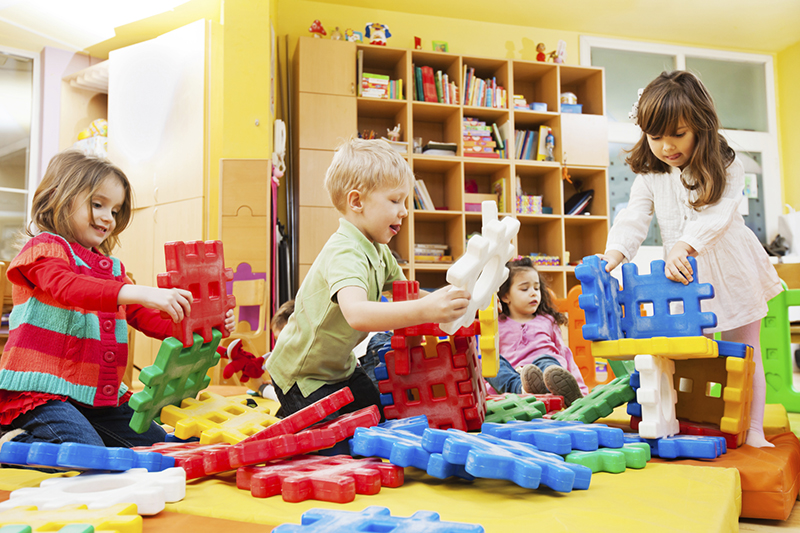
During the preschool years, children begin to assert their power and control over the world through directing play and other social interactions.
Children who are successful at this stage feel capable and able to lead others. Those who fail to acquire these skills are left with a sense of guilt, self-doubt, and a lack of initiative.
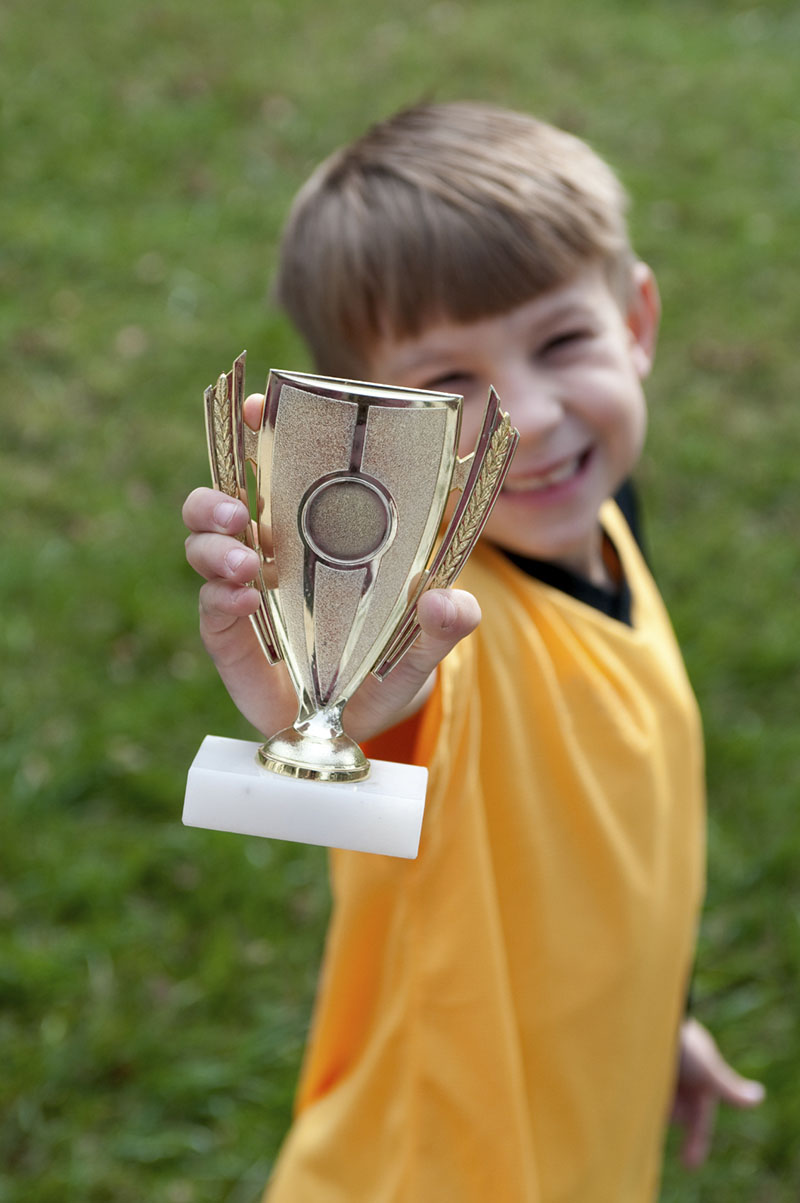
This stage covers the early school years from approximately age 5 to 11.
Through social interactions, children begin to develop a sense of pride in their accomplishments and abilities.
Children who are encouraged and commended by parents and teachers develop a feeling of competence and belief in their skills. Those who receive little or no encouragement from parents, teachers, or peers will doubt their abilities to be successful.
How are Freud and Erikson’s theories similar?
Freud and Erikson were both psychoanalytic theorists. Both believed that personality develops in a series of stages. For example, they believed that toilet training was an essential step in a child developing a sense of self control.
How are their theories different?
A major difference between the two theories pertains to how we develop in childhood and beyond. Freud’s theory says that our conscious and unconscious minds are often in conflict very early in life, which affects our behaviour as adults. We essentially become stuck in these negative patterns unless we seek professional psychiatric help as adults. Erikson said the conscious self continues to develop through social interactions throughout one’s life and that people are motivated by a desire for a sense of competence.
Jean Piaget
Have you ever noticed a baby get excited when his or her parent (mom or dad) enters a room? Maybe the child is yours and when you go and get them in the morning they reach out to you. What if the person was a stranger? Would the baby change their reaction? Why?

The theorist who spent time researching the stages of development with respect to how a child learns was Jean Piaget. While both Erikson and Freud were psychoanalytic theorists, Jean Piaget was a cognitive theorist. Where Freud and Erikson describe behaviour and how it develops, Piaget’s theories are used to explain how thinking may develop.
Piaget was most interested in how an individual develops their intelligence and thought processes. Think of his theories as being like a construction site where the work is never quite finished. According to Piaget, there is a constant building phase to how a person’s thoughts and intelligence develops. His first phase explained that a child under two is able to identify objects in their environment.
Piaget described four main stages of cognitive development.
During this time, Piaget said that a child's cognitive system is limited to motor reflexes at birth, but the child builds on these reflexes to develop more sophisticated procedures. They learn to generalize their activities to a wider range of situations and coordinate them into increasingly lengthy chains of behaviour.
As opposed to preoperational children, children in the concrete operations stage are able to take another's point of view and take into account more than one perspective simultaneously. They can also represent transformations as well as static situations. Although they can understand concrete problems, Piaget would argue that they cannot yet solve abstract problems, and that they do not consider all of the logically possible outcomes.
As opposed to preoperational children, children in the concrete operations stage are able to take another's point of view and take into account more than one perspective simultaneously. They can also represent transformations as well as static situations. Although they can understand concrete problems, Piaget would argue that they cannot yet solve abstract problems, and that they do not consider all of the logically possible outcomes.
Children who attain the formal operations stage are capable of thinking logically and abstractly. They can also reason theoretically. Piaget considered this the ultimate stage of development, and stated that although the children would still have to revise their knowledge base, their way of thinking was as powerful as it would get.
Matching quiz
Now test your knowledge on Jean Piaget’s theory.
Fun fact:
Did you know that many kindergarten programs in Ontario are based on Piaget’s theories?
Lev Vygotsky
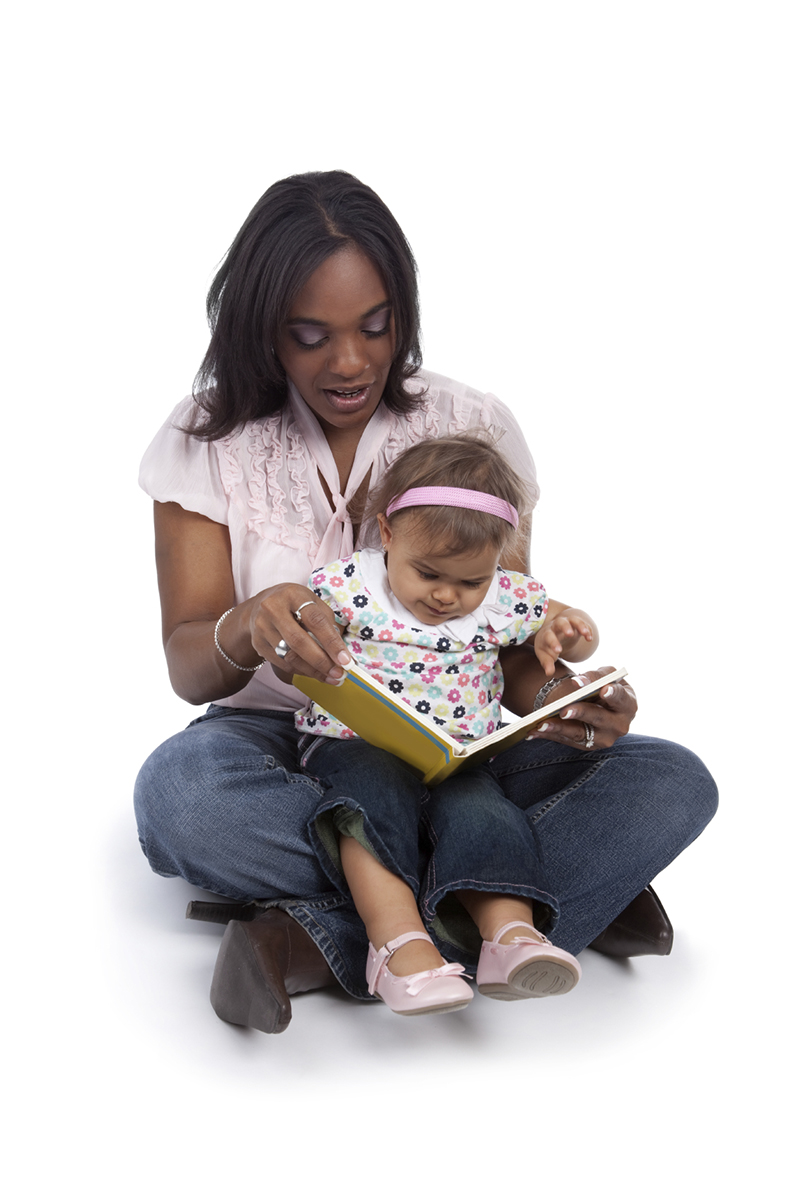
Remember that you learned that Piaget’s theory about how thinking develops might be compared to a construction site? Well, Lev Vygotsky shared Piaget’s theory that development is the product of particular kinds of interactivity.
Vygotsky used a multi-faceted approach to his development theory. He essentially described people who play the role of teacher as being more knowledgeable others (MKO). Parents, caregivers, older siblings, grandparents could all be an MKO in different circumstances.
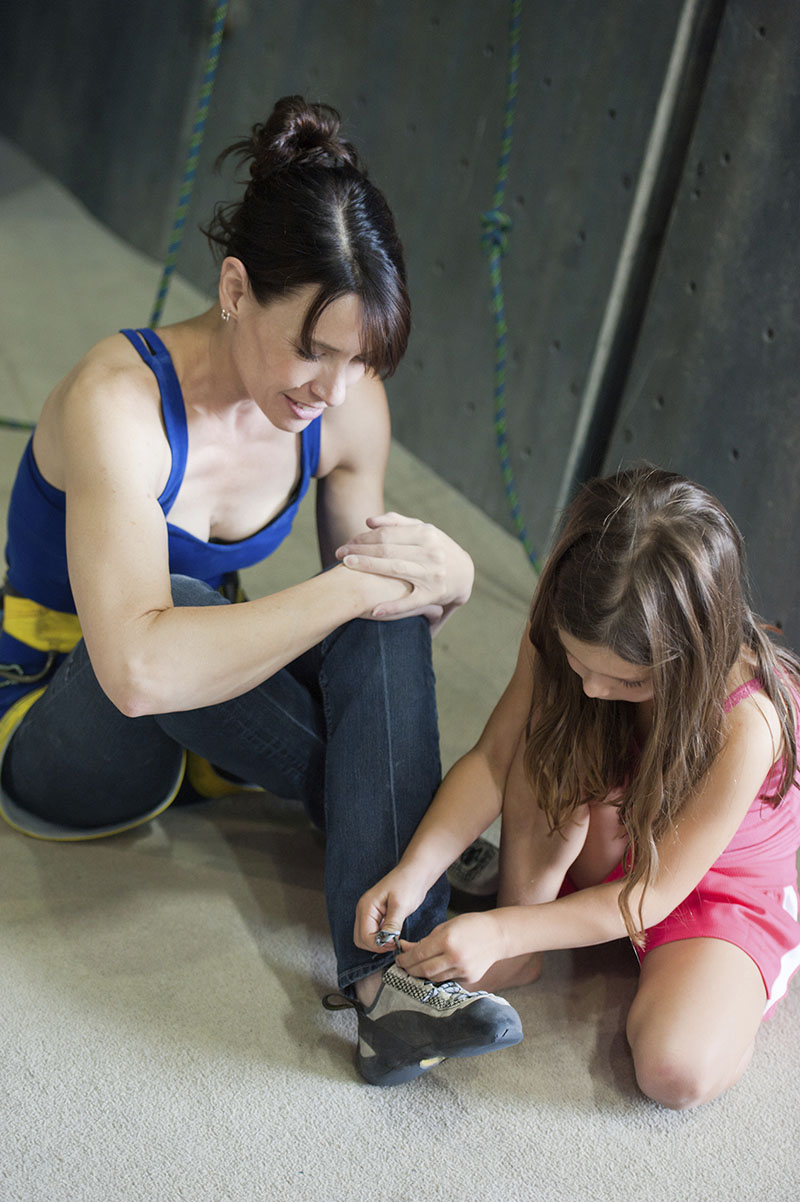
The MKO or learning guide is responsible for three things:
- Getting the child’s attention
- Demonstrating the skill
- Structuring the interaction to meet the child’s needs so that the child can learn. Vygotsky’s theory describes the process of scaffolding: do this first, then this, then this.
Consider how you have used the scaffolding approach when you were trying to show someone how to do something. For example, you may have taught your child or another child how to tie their shoes, or helped them to read a book.
Think of a scenario where you have scaffolded the learning for a child and answer the following questions. Be sure to think carefully about these questions as you will need this later.
How did you get the person’s attention?
How did you demonstrate the skill?
How did you structure the interaction to help the person learn?
Using the principles of scaffolding, what will you do differently next time to make the teaching more successful?
Urie Bronfenbrenner
Have you ever heard that it takes a village to raise a child? Urie Bronfenbrenner thought so.
Like Vygotsky, Urie Bronfenbrenner believed development is the product of interactions between the person and their family, neighbourhood, community, society, beliefs, and personal values.
Bronfenbrenner believed that people develop in an ecology. This ecology has three levels, microsystem, mesosystem, and macrosystem, which will be described in the next section.
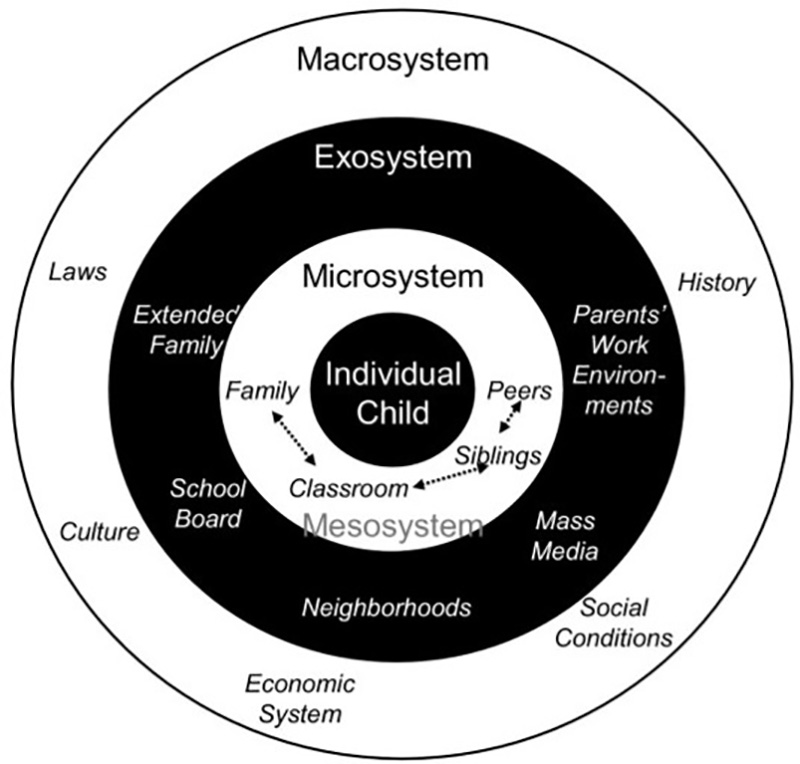
Bronfenbrenner’s levels of ecology for the individual child; Microsystem: family, siblings, peers, classroom Mesosystem: the relationship between microsystems like family, classroom, siblings, and peers, Exosystem: parents’ work environments, mass media, school board, extended family, and Macrosystem: laws, culture, economic system, social conditions, history

Microsystem refers to the setting in which the individual lives. These contexts include the person's family, peers, school, religion, and neighbourhood. It is in the microsystem that the most direct interactions with social agents take place, with parents, peers, and teachers, for example.
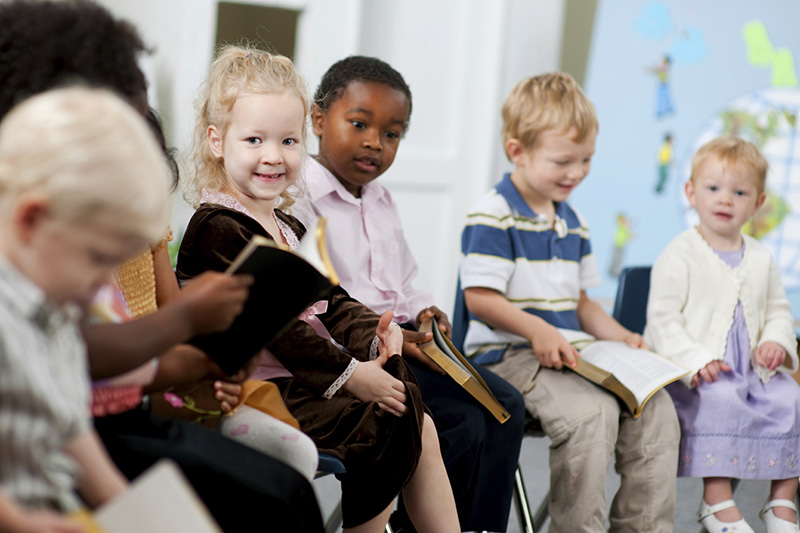
Mesosystem refers to relations between microsystems. Examples are the relationship of family experiences to school experiences, school experiences to church experiences, and family experiences to peer experiences. For example, children whose family experience involves their parents rejecting them may have more difficulty developing positive relations with teachers.

Macrosystem describes the culture in which individuals live. Cultural contexts can be thought of broadly to include whether the culture is found in a developing or industrialized country, the socioeconomic status of the cultural group, the presence or absence of poverty, and the kind of ethnicity.
For more information about this theory, watch “Bronfenbrenner’s ecological systems.”
Source: Courtesy of Ben Price.
Scenario: About a family
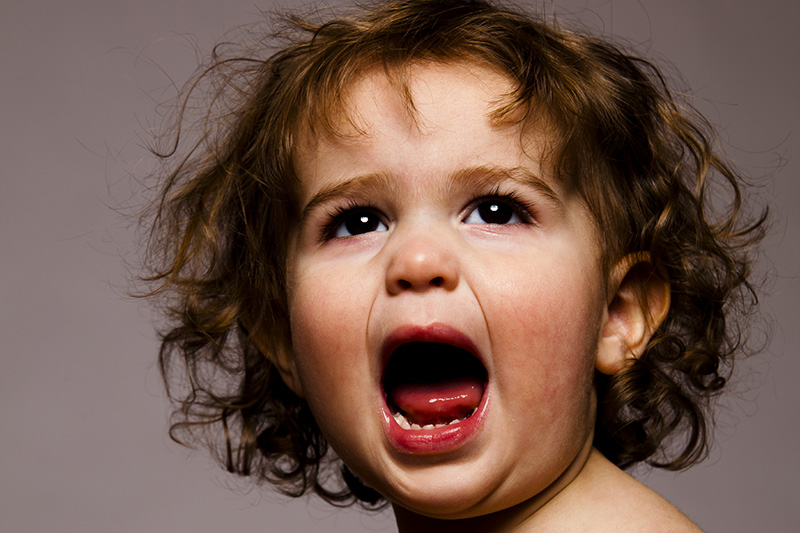
Respond to the following scenario. She’s two … need we say more?
You are assisting the Smith family by babysitting. While the parents are out, two-year-old Kate grabs a favourite toy truck from her four-year-old brother, Sam. Now truck-less, Sam begins to cry and attempts to hit Kate. Kate screams and runs away with the toy still in her hand.
Questions:
Using your knowledge of growth and development, how would you respond?
Whose theory would be helpful in formulating your response: Piaget, Vygotsky, Freud, Erikson, or Bronfenbrenner?
- Piaget’s theory of the stage that a two-year-old has reached as compared to a four-year-old would be useful. Since Kate is still in the sensorimotor stage, all actions are reflex-based and done without any complex thought. Meanwhile, Sam is in the preoperational stage and is very egocentric, unable to see things from his sister’s viewpoint.
- Vygotsky’s theory about logic and reasoning can be used to help four-year-old Sam deal with sharing the toy instead of reacting poorly. As the babysitter, you can provide a scaffolded approach by showing Kate how to give the toy back.
- Freud’s theory in satisfying the id of a child can be used to explain Sam not being able to comprehend the loss of his toy. His id wants the toy back and he will not stop crying until he has it.
- Erikson’s theory would say that this is an issue of trust vs. mistrust. It is important that Sam understands that his younger sister will not take every toy she wants or looks at. Erikson’s ages of development would indicate that Kate is responding to a “crisis” when she screams and runs away.
- According to Bronfenbrenner, this toy-taking scenario is related to the microsystem and is part of learning about life. Kate and Sam are immediate family and therefore in a microsystem together.
Common child development myths
In the following activity, answer whether each statement is true or false.
Portfolio item
Use the Internet to do your own research on common child development myths and false assumptions. Discover the truth behind these myths by checking reputable websites, such as those provided by Health Canada, your local government, or Canadian universities. You will need this research in the Portfolio item that will be discussed on the next section.
Portfolio
You will be creating a Portfolio in this course. Whenever there is a Portfolio assignment you will see this icon. Create a folder on your computer and put all these Portfolio assignments in it. At the end of the course, you will submit your complete Portfolio for marking.
Instructions:
Your local health unit has asked you to prepare a flyer for new parents dismissing some myths about childhood development. Using your own knowledge, your family’s assumptions, or things you hear people say, create your own “Child development myths versus reality” flyer. Think of a catchy title and make the flyer visually appealing. Be sure to research the truth behind these child development myths and assumptions and include the truth in your flyer. Be sure to put any quotes in quotation marks and cite your source.
Your flyer should have 7–10 myths in total and their actual reality explained.
Save your visually attractive flyer called “Learning activity 1.1: Child development myths versus reality” in your Portfolio folder. Do not wait. Do the assignment now.
Example
A dad doesn’t play as important a role as a mom. Myth! Dads and Moms are both important in a child’s normal development.
Reality: “Even from birth, children who have an involved father are more likely to be emotionally secure, be confident to explore their surroundings, and, as they grow older, have better social connections. The way fathers play with their children also has an important impact on a child’s emotional and social development. Fathers spend a higher percentage of their one-to-one interactions with infants and preschoolers in stimulating, playful activity than do mothers. From these interactions, children learn how to regulate their feelings and behavior. Children with involved, caring fathers have better educational outcomes. The influence of a father’s involvement extends into adolescence and young adulthood. Numerous studies find that an active and nurturing style of fathering is associated with better verbal skills, intellectual functioning, and academic achievement among adolescents.”
Information source: www.childwelfare.gov/pubs/usermanuals/fatherhood/fatherhood.pdf

